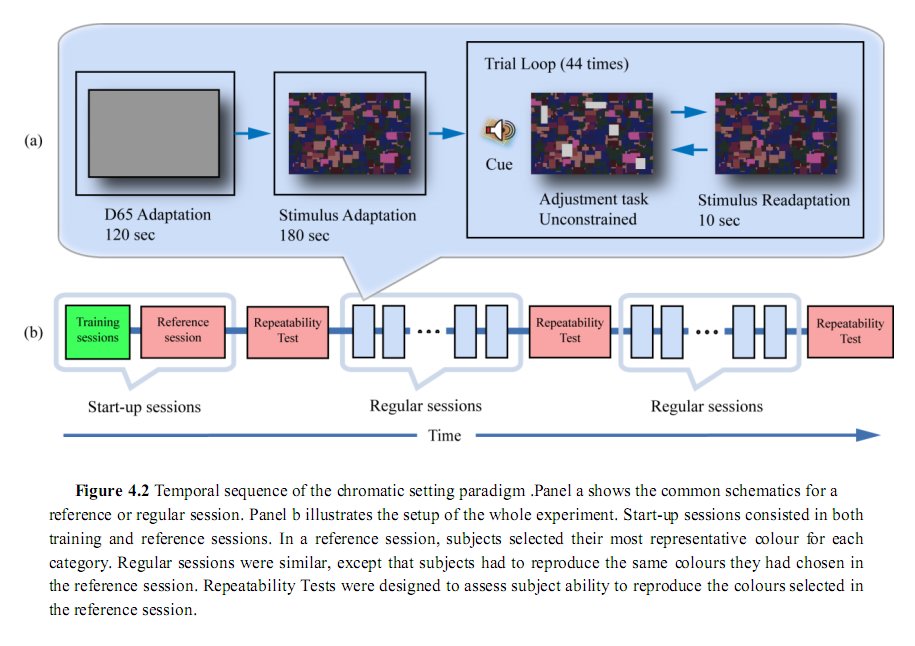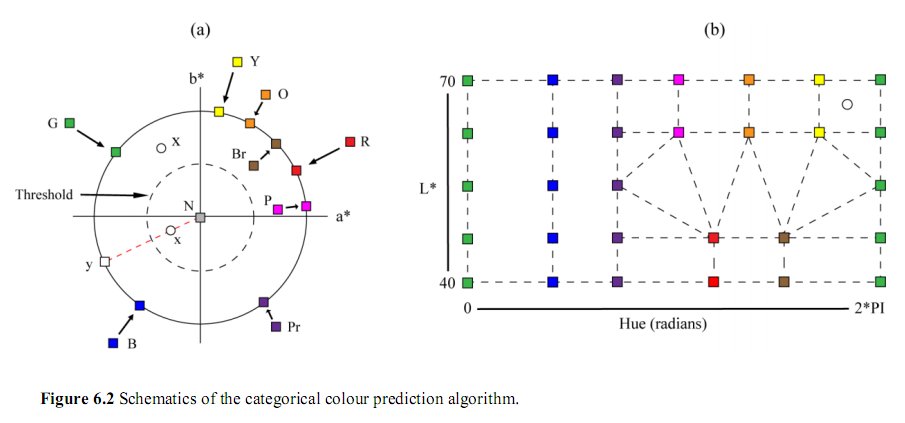|
Colour in Context
Research group Computer Vision Center |
 |
Chromatic Settings
To recognise objects is perhaps the most important task an autonomous system, either biological or artificial needs to perform. In the context of human vision, this is partly achieved by recognizing the colour of surfaces despite changes in the wavelength distribution of the illumination, a property called colour constancy. Correct surface colour recognition may be adequately accomplished by colour category matching without the need to match colours precisely, therefore categorical colour constancy is likely to play an important role for object identification to be successful.
The main aim of this work is to study the relationship between colour constancy and categorical colour perception. Previous studies of colour constancy have shown the influence of factors such the spatio-chromatic properties of the background, individual observer's performance, semantics, etc. However there is very little systematic study of these influences. To this end, we developed a new approach to colour constancy which includes both individual observers' categorical perception, the categorical structure of the background, and their interrelations resulting in a more comprehensive characterization of the phenomenon.
In our study, we developed new colour constancy paradigm, termed chromatic setting, which allows measuring the precise location of nine categorically-relevant points in colour space under immersive illumination. Additionally, we derived from these measurements a new colour constancy index which takes into account the magnitude and orientation of the chromatic shift, memory effects and the interrelations among colours and a model of colour naming tuned to each observer/adaptation state.
Our results lead to the following conclusions: (1) There exists large inter-individual variations in the categorical structure of colour space, and thus colour naming ability varies significantly but this is not well predicted by low-level chromatic discrimination ability; (2) Analysis of the average colour naming space suggested the need for an additional three basic colour terms (turquoise, lilac and lime) for optimal colour communication; (3) Chromatic setting improved the precision of more complex linear colour constancy models and suggested that mechanisms other than cone gain might be best suited to explain colour constancy; (4) The categorical structure of colour space is broadly stable under illuminant changes for categorically balanced backgrounds; (5) Categorical inconstancy exists for categorically unbalanced backgrounds thus indicating that categorical information perceived in the initial stages of adaptation may constrain further categorical perception.
Publications
Roca-Vila, J., Parraga, C. A., & Vanrell, M. (2012). Predicting categorical colour perception in successive colour constancy, Perception 41(Suppl.), 183b.
Roca-Vila J., Vanrell M., Parraga C. A. (2012). What is constant in colour constancy?.CGIV2012/MCS'10 -Proceedings of the 6th European Conference on Colour in Graphics, Imaging - 12th International Symposium on Multispectral Colour Science. Society for Imaging Science and Technology, pp. 337-343
Roca-Vila, J., Parraga, C. A., & Vanrell, M. (2011). Categorical focal colours are structurally invariant under illuminant changes Perception, Perception, 40(Suppl.), 196b.
Roca-Vila, J., Owen, A., Jordan, G., Ling, Y., Parraga, C.A., Hurlbert, A., (2011) Inter-individual variations in color naming and the structure of 3D color space, VSS - Vision Sciences Society 11th Annual Meeting. Journal of Vision, vol. 11, No.11, article 386.
Parraga, C. A., Roca-Vila, J., Vanrell, M. (2011) Do basic colors influence chromatic adaptation? VSS - Vision Sciences Society 11th Annual Meeting. Journal of Vision, vol. 11, No. 11, article 349.


